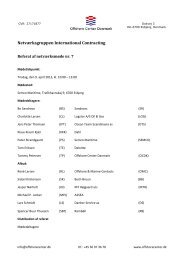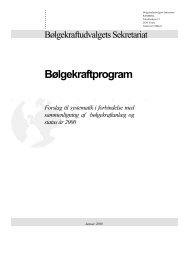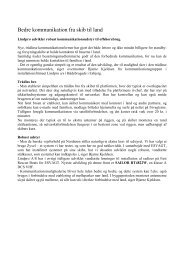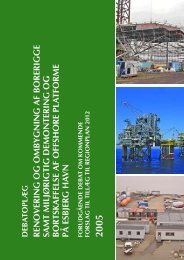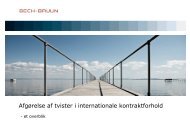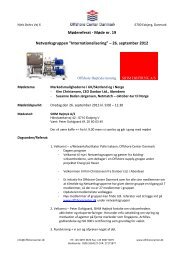Create successful ePaper yourself
Turn your PDF publications into a flip-book with our unique Google optimized e-Paper software.
Poseidon’s<br />
Organ<br />
By Chief Executive Officer Partner<br />
Claus H. Sivager and Project Manager<br />
Torben Holm, Birch & Krogboe A/S<br />
Introduction<br />
Poseidon’s Organ is an invention, an ambition<br />
and a specific plan to develop and construct<br />
sustainable energy power plants in scale,<br />
output and economy surmounting all previous<br />
attempts to transform the oceans infinite<br />
resources into electricity. One single power<br />
plant unit is able to supply 12,500 households<br />
with electricity from its position in rough<br />
waters. The approximately 230 metres wide<br />
triangular power plant unit is capable of resisting<br />
conditions 10 kilometres off Portuguese<br />
and Irish coasts. Here wind conditions and<br />
energy rich waves create perfect conditions<br />
for a wave power plant, the first of its kind,<br />
conceptualised and designed for industrial<br />
energy production. Model tests and measurements<br />
clearly indicate Poseidon’s Organ will<br />
pull the wave energy out of the experimental<br />
research laboratory and put it among future<br />
sustainable energy sources. At present, a<br />
demonstration plant placed off the Portuguese<br />
coast is to verify the fine output and operation<br />
stability calculations and model tests already<br />
show, thus proving Poseidon’s Organ a very<br />
serious investment case – both in terms of<br />
future environment and in terms of economic<br />
return for a professional investor.<br />
Scientific and Technological<br />
Aims of the Project<br />
Effective Wave Energy Production<br />
Poseidon’s Organ is based on two patents and<br />
12 inventions in total. Prototypes in scale 1:25<br />
and 1:50 have through the support of the Danish<br />
Energy Board been tested and have shown<br />
very promising results in off-shore tanks and<br />
wave basins. The project is now ready for a<br />
test and demonstration plant at large scale.<br />
The idea is to build demonstration plants<br />
to identify and surmount possible technical<br />
barriers operating a plant at large scale and<br />
simultaneously demonstrating potential advan-<br />
10 <strong>Offshore</strong> <strong>Center</strong> Denmark<br />
Newsletter <strong>ON</strong>/<strong>OFF</strong> 10 - May 2007<br />
tages and cost efficiency in energy production<br />
based on wave power.<br />
The project aims to transfer experience and<br />
technology from patents and model tests to<br />
the development of a prototype plant. The<br />
plant is to be located in the Atlantic Ocean off<br />
the Portuguese coast. Portugal is chosen due<br />
to favourable wave conditions, and because<br />
Portugal is a leading European nation within<br />
wave power technology. Furthermore Portugal<br />
has competent partners with close relations to<br />
the European energy market.<br />
The output of the demonstration plant is based<br />
on key figures, model calculations and mean<br />
data deriving from tests carried out. The plant<br />
must first and foremost confirm the following:<br />
- the ability to utilize at least 35 percent of<br />
the inherent energy in waves and transform<br />
it into electricity<br />
- the ability to produce a total output of<br />
30,000 kW on the demonstration plant<br />
including three windmills<br />
- the ability to achieve an output on wave<br />
power energy equivalent to 28GWh a year<br />
when the demonstration plant is located in<br />
the Atlantic Ocean off the Portuguese west<br />
coast<br />
- the ability to achieve an output from three<br />
windmills reaching in total 22GWh a year<br />
How does it work?<br />
Figure 1 illustrates how waves always hit the<br />
front of the plant. The explanation is to be<br />
found in the patented anchoring system. The<br />
front of the wave power plant is 230 metres<br />
wide and consists of 10 floats. The float<br />
absorbs the energy inherent in the waves. A<br />
double functioning pump then transforms the<br />
wave energy into water flow driving a turbine<br />
or generator producing electricity. It is the<br />
uniqueness of the float that ensures optimal<br />
absorption of the energy inherent in the waves.<br />
The design of the floats is a result of model<br />
calculations and numerous tests.<br />
Cost effectiveness/efficiency<br />
It is a project goal to develop a cost efficient<br />
technology improving competitiveness and<br />
acceptance of wave energy in the market for<br />
sustainable energy. The construction costs<br />
of Poseidon’s Organ are estimated at 41.5<br />
million EUR.<br />
Figure 1




